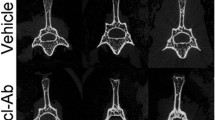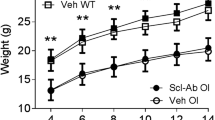Abstract
Sclerostin functions as an antagonist to Wnt signaling and inhibits bone-forming activity. We studied the effects of skeletal unloading and treatment with sclerostin antibody (Scl-Ab) on mesenchymal stem cell, osteoprogenitor and osteoclast precursor pools, and their relationship to bone formation and resorption. Male C57BL/6 mice (5-months-old) were hind limb unloaded for 1 week or allowed normal ambulation and treated with Scl-Ab (25 mg/kg, s.c. injections on days 1 and 4) or placebo. Unloading decreased the serum concentration of bone formation marker P1NP (−35 %), number of colony-forming units (CFU) (−38 %), alkaline phosphatase–positive CFUs (CFU-AP+) (−51 %), and calcified nodules (−35 %); and resulted in a fourfold increase in the number of osteoclast precursors. The effects of Scl-Ab treatment on unloaded and normally loaded mice were nearly identical; Scl-Ab increased serum P1NP and the number of CFU, CFU-AP+, and calcified nodules in ex vivo cultures; and increased osteoblast and bone mineralizing surfaces in vivo. Although the marrow-derived osteoclast precursor population increased with Scl-Ab, the bone osteoclast surface did not change, and the serum concentration of osteoclast activity marker TRACP5b decreased. Our data suggest that short-term Scl-Ab treatment can prevent the decrease in osteoprogenitor population associated with skeletal unloading and increase osteoblast surface and bone mineralizing surface in unloaded animals. The anabolic effects of Scl-Ab treatment on bone are preserved during skeletal unloading. These findings suggest that Scl-Ab treatment can both increase bone formation and decrease bone resorption, and provide a new means for prevention and treatment of disuse osteoporosis.



Similar content being viewed by others
References
Yaccoby S, Ling W, Zhan F, Walker R, Barlogie B, Shaughnessy JD Jr (2007) Antibody-based inhibition of DKK1 suppresses tumor-induced bone resorption and multiple myeloma growth in vivo. Blood 109:2106–2111
Bodine P, Stauffer B, Ponce-de-Leon H, Bhat B, Mangine A, Seestaller-Wehr L (2007) A small molecule inhibitor of the Wnt antagonist secreted frizzled-related protein (SFRP)-1 stimulates bone formation. Abstracts of the 29th Annual Meeting of the American Society for Bone and Mineral Research
Kulkarni NH, Wei T, Kumar A, Dow ER, Stewart TR, Shou J, N’Cho M, Sterchi DL, Gitter BD, Higgs RE, Halladay DL, Engler TA, Martin TJ, Bryant HU, Ma YL, Onyia JE (2007) Changes in osteoblast, chondrocyte, and adipocyte lineages mediate the bone anabolic actions of PTH and small molecule GSK-3 inhibitor. J Cell Biochem 102:1504–1518
Padhi D, Jang G, Stouch B, Fang L, Posvar E (2011) Single-dose, placebo-controlled, randomized study of AMG 785, a sclerostin monoclonal antibody. J Bone Miner Res 26:19–26
Bennett CN, Longo KA, Wright WS, Suva LJ, Lane TF, Hankenson KD, MacDougald OA (2005) Regulation of osteoblastogenesis and bone mass by Wnt10b. Proc Natl Acad Sci U S A 102:3324–3329
Andrade AC, Nilsson O, Barnes KM, Baron J (2007) Wnt gene expression in the post-natal growth plate: regulation with chondrocyte differentiation. Bone 40:1361–1369
Poole KE, van Bezooijen RL, Loveridge N, Hamersma H, Papapoulos SE, Lowik CW, Reeve J (2005) Sclerostin is a delayed secreted product of osteocytes that inhibits bone formation. FASEB J 19:1842–1844
Irie K, Ejiri S, Sakakura Y, Shibui T, Yajima T (2008) Matrix mineralization as a trigger for osteocyte maturation. J Histochem Cytochem 56:561–567
Li X, Ominsky MS, Niu QT, Sun N, Daugherty B, D’Agostin D, Kurahara C, Gao Y, Cao J, Gong J, Asuncion F, Barrero M, Warmington K, Dwyer D, Stolina M, Morony S, Sarosi I, Kostenuik PJ, Lacey DL, Simonet WS, Ke HZ, Paszty C (2008) Targeted deletion of the sclerostin gene in mice results in increased bone formation and bone strength. J Bone Miner Res 23:860–869
Li X, Warmington KS, Niu QT, Asuncion FJ, Barrero M, Grisanti M, Dwyer D, Stouch B, Thway TM, Stolina M, Ominsky MS, Kostenuik PJ, Simonet WS, Paszty C, Ke HZ (2010) Inhibition of sclerostin by monoclonal antibody increases bone formation, bone mass, and bone strength in aged male rats. J Bone Miner Res 25:2647–2656
Li X, Ominsky MS, Warmington KS, Morony S, Gong J, Cao J, Gao Y, Shalhoub V, Tipton B, Haldankar R, Chen Q, Winters A, Boone T, Geng Z, Niu QT, Ke HZ, Kostenuik PJ, Simonet WS, Lacey DL, Paszty C (2009) Sclerostin antibody treatment increases bone formation, bone mass, and bone strength in a rat model of postmenopausal osteoporosis. J Bone Miner Res 24:578–588
Glass DA 2nd, Bialek P, Ahn JD, Starbuck M, Patel MS, Clevers H, Taketo MM, Long F, McMahon AP, Lang RA, Karsenty G (2005) Canonical Wnt signaling in differentiated osteoblasts controls osteoclast differentiation. Dev Cell 8:751–764
Spencer GJ, Utting JC, Etheridge SL, Arnett TR, Genever PG (2006) Wnt signalling in osteoblasts regulates expression of the receptor activator of NFkappaB ligand and inhibits osteoclastogenesis in vitro. J Cell Sci 119:1283–1296
Valencia J, Hernandez-Lopez C, Martinez VG, Hidalgo L, Zapata AG, Vicente A, Varas A, Sacedon R (2010) Transient beta-catenin stabilization modifies lineage output from human thymic CD34+CD1a− progenitors. J Leukoc Biol 87:405–414
Takahashi N, Maeda K, Ishihara A, Uehara S, Kobayashi Y (2011) Regulatory mechanism of osteoclastogenesis by RANKL and Wnt signals. Front Biosci 16:21–30
Kubota T, Michigami T, Ozono K (2009) Wnt signaling in bone metabolism. J Bone Miner Metab 27:265–271
Zerwekh JE, Ruml LA, Gottschalk F, Pak CY (1998) The effects of twelve weeks of bed rest on bone histology, biochemical markers of bone turnover, and calcium homeostasis in eleven normal subjects. J Bone Miner Res 13:1594–1601
Wronski TJ, Morey ER (1982) Skeletal abnormalities in rats induced by simulated weightlessness. Metab Bone Dis Relat Res 4:69–75
Bikle DD, Halloran BP (1999) The response of bone to unloading. J Bone Miner Metab 17:233–244
Morey-Holton E, Globus RK, Kaplansky A, Durnova G (2005) The hindlimb unloading rat model: literature overview, technique update and comparison with space flight data. Adv Space Biol Med 10:7–40
Sibonga JD, Zhang M, Evans GL, Westerlind KC, Cavolina JM, Morey-Holton E, Turner RT (2000) Effects of spaceflight and simulated weightlessness on longitudinal bone growth. Bone 27:535–540
Halloran BP, Bikle DD, Wronski TJ, Globus RK, Levens MJ, Morey-Holton E (1986) The role of 1,25-dihydroxyvitamin D in the inhibition of bone formation induced by skeletal unloading. Endocrinology 118:948–954
Sessions ND, Halloran BP, Bikle DD, Wronski TJ, Cone CM, Morey-Holton E (1989) Bone response to normal weight bearing after a period of skeletal unloading. Am J Physiol 257:E606–E610
Dehority W, Halloran BP, Bikle DD, Curren T, Kostenuik PJ, Wronski TJ, Shen Y, Rabkin B, Bouraoui A, Morey-Holton E (1999) Bone and hormonal changes induced by skeletal unloading in the mature male rat. Am J Physiol 276:E62–E69
Machwate M, Zerath E, Holy X, Pastoureau P, Marie PJ (1994) Insulin-like growth factor-I increases trabecular bone formation and osteoblastic cell proliferation in unloaded rats. Endocrinology 134:1031–1038
Amblard D, Lafage-Proust MH, Laib A, Thomas T, Ruegsegger P, Alexandre C, Vico L (2003) Tail suspension induces bone loss in skeletally mature mice in the C57BL/6J strain but not in the C3H/HeJ strain. J Bone Miner Res 18:561–569
Wronski TJ, Morey ER (1983) Inhibition of cortical and trabecular bone formation in the long bones of immobilized monkeys. Clin Orthop Relat Res 181:269–276
Robling AG, Niziolek PJ, Baldridge LA, Condon KW, Allen MR, Alam I, Mantila SM, Gluhak-Heinrich J, Bellido TM, Harris SE, Turner CH (2008) Mechanical stimulation of bone in vivo reduces osteocyte expression of Sost/sclerostin. J Biol Chem 283:5866–5875
Papanicolaou SE, Phipps RJ, Fyhrie DP, Genetos DC (2009) Modulation of sclerostin expression by mechanical loading and bone morphogenetic proteins in osteogenic cells. Biorheology 46:389–399
Galea GL, Sunters A, Meakin LB, Zaman G, Sugiyama T, Lanyon LE, Price JS (2011) Sost down-regulation by mechanical strain in human osteoblastic cells involves PGE2 signaling via EP4. FEBS Lett 585:2450–2454
Sakai A, Nakamura T (2001) Changes in trabecular bone turnover and bone marrow cell development in tail-suspended mice. J Musculoskelet Neuronal Interact 1:387–392
David V, Lafage-Proust MH, Laroche N, Christian A, Ruegsegger P, Vico L (2006) Two-week longitudinal survey of bone architecture alteration in the hindlimb-unloaded rat model of bone loss: sex differences. Am J Physiol Endocrinol Metab 290:E440–E447
Grano M, Mori G, Minielli V, Barou O, Colucci S, Giannelli G, Alexandre C, Zallone AZ, Vico L (2002) Rat hindlimb unloading by tail suspension reduces osteoblast differentiation, induces IL-6 secretion, and increases bone resorption in ex vivo cultures. Calcif Tissue Int 70:176–185
Kodama Y, Dimai HP, Wergedal J, Sheng M, Malpe R, Kutilek S, Beamer W, Donahue LR, Rosen C, Baylink DJ, Farley J (1999) Cortical tibial bone volume in two strains of mice: effects of sciatic neurectomy and genetic regulation of bone response to mechanical loading. Bone 25:183–190
Basso N, Jia Y, Bellows CG, Heersche JN (2005) The effect of reloading on bone volume, osteoblast number, and osteoprogenitor characteristics: studies in hind limb unloaded rats. Bone 37:370–378
Lueken SA, Arnaud SB, Taylor AK, Baylink DJ (1993) Changes in markers of bone formation and resorption in a bed rest model of weightlessness. J Bone Miner Res 8:1433–1438
Minaire P, Meunier P, Edouard C, Bernard J, Courpron P (1975) Histomorphometric and biological data on osteoporosis due to immobilization. Rev Rhum Mal Osteoartic 42:479–488
Inoue M, Tanaka H, Moriwake T, Oka M, Sekiguchi C, Seino Y (2000) Altered biochemical markers of bone turnover in humans during 120 days of bed rest. Bone 26:281–286
Tian X, Jee WS, Li X, Paszty C, Ke HZ (2011) Sclerostin antibody increases bone mass by stimulating bone formation and inhibiting bone resorption in a hindlimb-immobilization rat model. Bone 48:197–201
Halloran BP, Bikle DD, Harris J, Tanner S, Curren T, Morey-Holton E (1997) Regional responsiveness of the tibia to intermittent administration of parathyroid hormone as affected by skeletal unloading. J Bone Miner Res 12:1068–1074
Rodda SJ, McMahon AP (2006) Distinct roles for Hedgehog and canonical Wnt signaling in specification, differentiation and maintenance of osteoblast progenitors. Development 133:3231–3244
Huang JC, Sakata T, Pfleger LL, Bencsik M, Halloran BP, Bikle DD, Nissenson RA (2004) PTH differentially regulates expression of RANKL and OPG. J Bone Miner Res 19:235–244
Kostenuik PJ, Halloran BP, Morey-Holton ER, Bikle DD (1997) Skeletal unloading inhibits the in vitro proliferation and differentiation of rat osteoprogenitor cells. Am J Physiol 273:E1133–E1139
Cao J, Venton L, Sakata T, Halloran BP (2003) Expression of RANKL and OPG correlates with age-related bone loss in male C57BL/6 mice. J Bone Miner Res 18:270–277
Agholme F, Isaksson H, Li X, Ke HZ, Aspenberg P (2011) Anti-sclerostin antibody and mechanical loading appear to influence metaphyseal bone independently in rats. Acta Orthop 82:628–632
Dufour C, Holy X, Marie PJ (2008) Transforming growth factor-beta prevents osteoblast apoptosis induced by skeletal unloading via PI3 K/Akt, Bcl-2, and phospho-Bad signaling. Am J Physiol Endocrinol Metab 294:E794–E801
Lin C, Jiang X, Dai Z, Guo X, Weng T, Wang J, Li Y, Feng G, Gao X, He L (2009) Sclerostin mediates bone response to mechanical unloading through antagonizing Wnt/beta-catenin signaling. J Bone Miner Res 24:1651–1661
Weerkamp F, Baert MR, Naber BA, Koster EE, de Haas EF, Atkuri KR, van Dongen JJ, Herzenberg LA, Staal FJ (2006) Wnt signaling in the thymus is regulated by differential expression of intracellular signaling molecules. Proc Natl Acad Sci U S A 103:3322–3326
Staal FJ, Weerkamp F, Baert MR, van den Burg CM, van Noort M, de Haas EF, van Dongen JJ (2004) Wnt target genes identified by DNA microarrays in immature CD34+ thymocytes regulate proliferation and cell adhesion. J Immunol 172:1099–1108
Acknowledgments
This work was supported by the Veterans Affairs Merit Review program, NASA, and the Northern California Institute for Research and Education.
Author information
Authors and Affiliations
Corresponding author
Additional information
Thomas Wronski received research funding from Amgen Inc. Marina Stolina and Hua Zhu Ke are employed by Amgen. Marina Stolina, Hua Zhu Ke, and Thomas Wronski have stock ownership in Amgen. Other authors have stated that they have no conflict of interest.
Rights and permissions
About this article
Cite this article
Shahnazari, M., Wronski, T., Chu, V. et al. Early Response of Bone Marrow Osteoprogenitors to Skeletal Unloading and Sclerostin Antibody. Calcif Tissue Int 91, 50–58 (2012). https://doi.org/10.1007/s00223-012-9610-9
Received:
Accepted:
Published:
Issue Date:
DOI: https://doi.org/10.1007/s00223-012-9610-9




